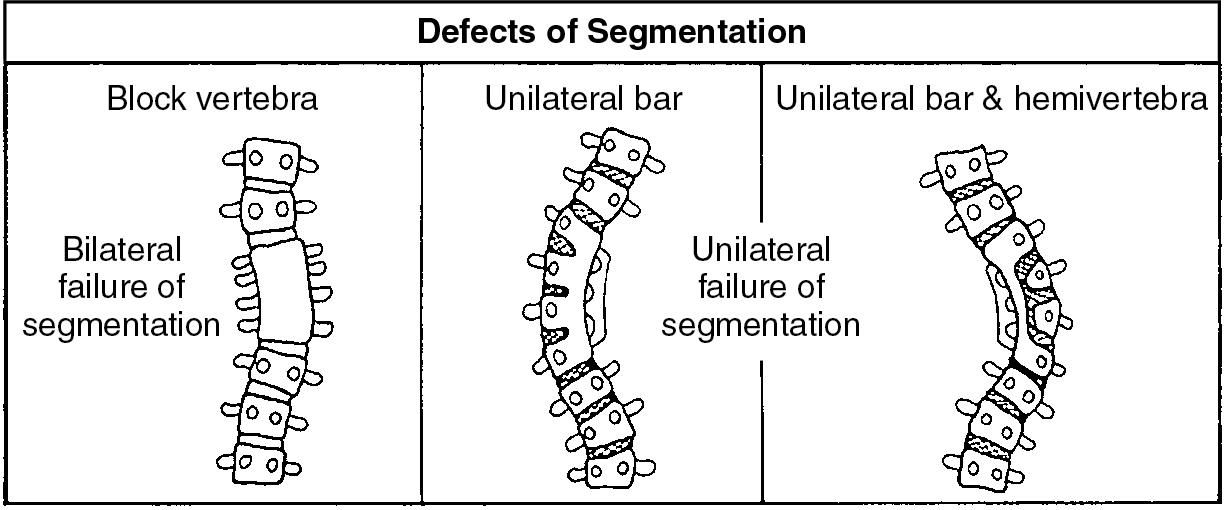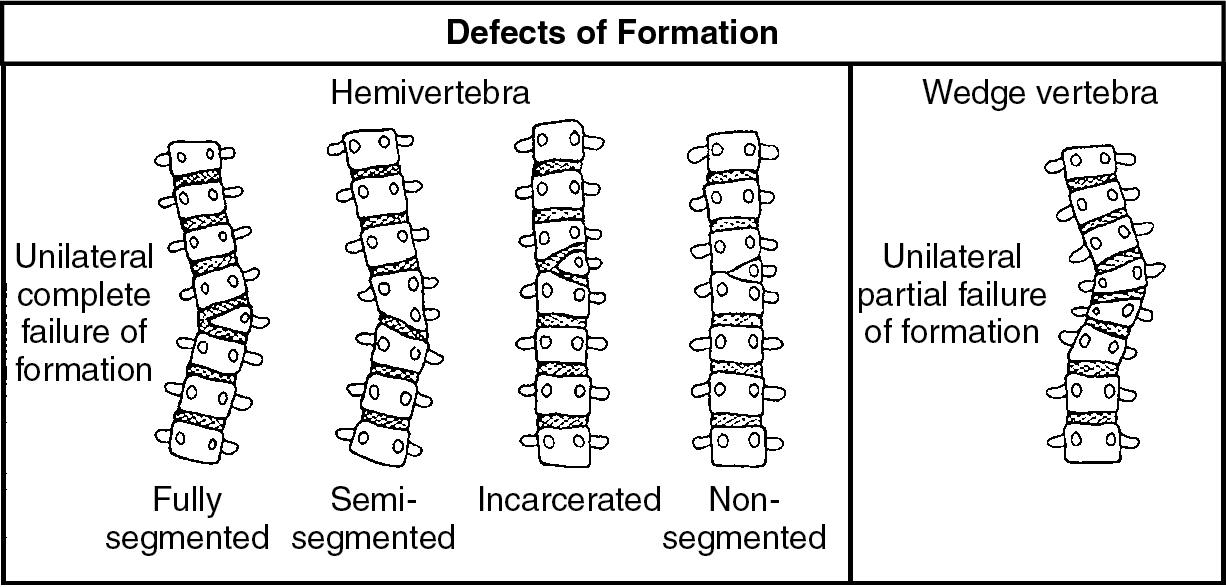Physical Address
304 North Cardinal St.
Dorchester Center, MA 02124
A lateral curvature of the spine caused by vertebral anomalies that produce a frontal plane growth asymmetry. The anomalies are present at birth, but the curvature may take years to become clinically evident.
Homeobox genes of the Hox class.
During weeks 4–6 of the embryonic period.
Defects of segmentation and defects of formation. Some congenital abnormalities cannot be placed into this classification scheme.
Block vertebra, unilateral bar, and unilateral bar and hemivertebra ( Fig. 39.1 ).

Hemivertebra and wedge vertebra ( Fig. 39.2 ).

Fully segmented, semisegmented, nonsegmented, and incarcerated.
Unbalanced growth. The greater the disparity in the number of healthy growth plates between the left and right sides of the spine, the greater the deformity and the more rapidly spinal deformity develops.
The anatomic type helps determine the risk and rate of progression.
The location of the defect affects spinal balance and difficulty of treatment. A hemivertebra located at the lumbosacral junction causes far more spinal imbalance than one located at the mid-thoracic level. In addition, a hemivertebra at the cervicothoracic junction is more difficult to treat surgically due to limited approach options, and timing of surgical intervention may be altered based on this consideration.
The patient age determines the risk of progression. Spinal deformities are more likely to progress during times of rapid growth, such as the first 2 years of life and during the adolescent growth spurt.
Unilateral unsegmented bar with contralateral hemivertebra (an average of 6° progression per year)
Unilateral unsegmented bar (an average of 5° progression per year)
Early in-situ fusion, because this deformity can only progress.
Fully segmented . There are two extra growth plates on one side of the spine. Unbalanced growth occurs, producing a scoliosis that worsens at a rate of 1° to 2° per year. Two fully segmented hemivertebrae on the same side of the spine produce a more rapid deterioration (about 3° per year).
Semisegmented . One border is synostosed to its neighbor, producing a balanced number of growth plates on either side. The hemivertebra produces a tilting of the spine, and a slowly progressive curvature may occur.
Nonsegmented . No growth plates are associated with this type of hemivertebra, and a progressive deformity does not occur.
Incarcerated . The vertebral bodies above and below accommodate the hemivertebra, and little or no deformity is produced. The growth plates tend to be narrow with little growth potential. This form of hemivertebra causes little or no deformity.
Sixty percent have malformations either within or outside the spine. A relatively benign vertebral abnormality may be associated with a life-threatening (but initially asymptomatic) problem. The importance of a thorough search for associated abnormalities cannot be overemphasized.
Vertebral abnormalities at another spinal level . For example, cervical vertebral anomalies are detected in 25% of people with congenital scoliosis or kyphosis.
Urinary tract structural abnormalities . Up to 37% of people with congenital vertebral anomalies have urinary tract anomalies, such as renal agenesis, duplication, ectopia, fusion, ureteral anomalies, and reflux.
Intraspinal abnormalities . Up to 38% of people with congenital vertebral anomalies have intraspinal abnormalities detectable by magnetic resonance imaging (MRI), including tethered cord, diastematomyelia, diplomyelia, and syringomyelia.
Other associated anomalies . Cranial nerve palsy (11%), upper extremity hypoplasia (10%), clubfoot (9%), dislocated hip (8%), and congenital cardiac disease (7%).
Become a Clinical Tree membership for Full access and enjoy Unlimited articles
If you are a member. Log in here